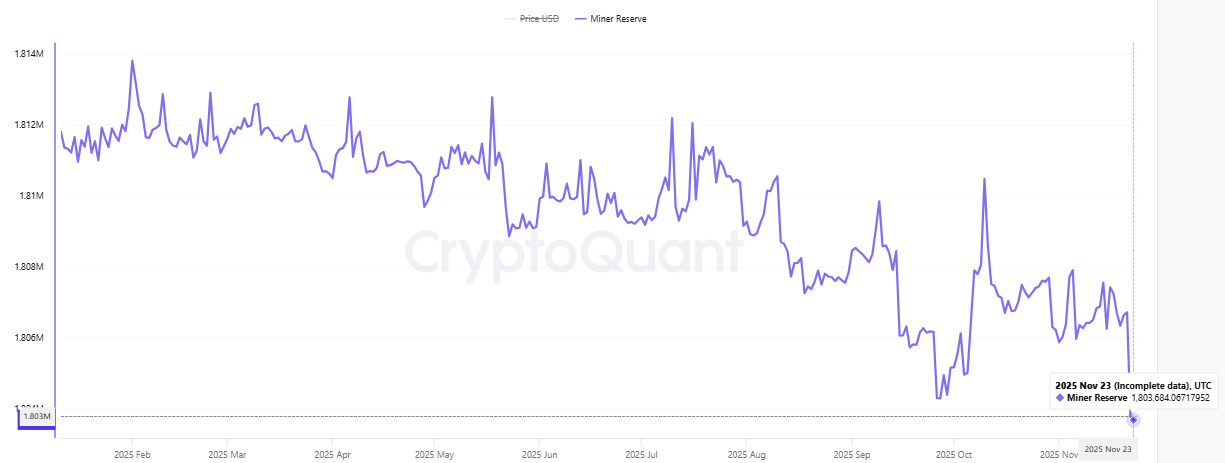Bitcoin Miner Reserves Plunge to Record Low as Revenue Collapses
Bitcoin hashprice has fallen over 50% to an all-time low, leaving most miners operating at a loss while network difficulty remains near peak levels.
Bitcoin miners are aggressively draining their reserves in a bid to shore up balance sheets against a historic collapse in revenue efficiency.
Data from CryptoQuant reveals that miners have transferred more than 30,000 Bitcoin, valued at around $2.6 billion, from their wallets since November 21.
Bitcoin Mining Faces Survival Phase as Reserves Fall to Lowest Level Ever
As a result, the exodus has pulled total miner reserves down to 1.803 million BTC, the lowest levels on record.
 Bitcoin Miners Reserve. Source:
Bitcoin Miners Reserve. Source:
This sudden liquidity event signals that operators are pivoting from accumulation to survival, forced to monetize hard assets to cover operational overhead as cash flows dry up.
The catalyst for the sell-off is a brutal deterioration in mining economics.
According to Hashrate Index data, Bitcoin’s hashprice has fallen more than 50% in recent weeks to an all-time low of $34.49 per petahash per second.
Hashprice is the industry standard for tracking daily revenue per unit of computing power.
 Bitcoin Hashprice Over the Past Year. Source:
Bitcoin Hashprice Over the Past Year. Source:
For context, even during the 2021 China mining ban and the depths of the 2022 bear market, this metric rarely dipped below $50.
The current levels imply that, for all but the most efficient operators, the cost of generating a new Bitcoin now exceeds the asset’s market price.
Compounding the pain is a stubborn disconnect between price and network difficulty. While Bitcoin has corrected 22% over the past month to trade near $86,075, the network’s total computing power has refused to budge.
The global hashrate remains elevated at over one zettahash, suggesting a high-stakes game is playing out across the sector.
This implies that well-capitalized public miners are keeping next-generation fleets online despite negative margins. They are effectively subsidizing production with equity issuance or cash reserves.
The strategy is designed to squeeze out smaller, private competitors who lack access to capital markets.
Considering this, industry analysts warn that if Bitcoin prices do not quickly reclaim their uptrend, the sector could face a prolonged wave of capitulation.
In that scenario, distressed miners may be forced to liquidate not only their Bitcoin holdings but their physical infrastructure as well.
Disclaimer: The content of this article solely reflects the author's opinion and does not represent the platform in any capacity. This article is not intended to serve as a reference for making investment decisions.
You may also like
GameStop's Profit Strategy: Short Sellers, Brick-and-Mortar Stores, and Interest Rate Expectations Intersect
- GameStop (GME) shares rose near 52-week lows amid high short interest and retail-driven speculation, with a potential short squeeze looming as open options activity surged. - Institutional investors cut $5.4B in MicroStrategy (MSTR) holdings, linking crypto-focused MSTR to GME's 2021 meme stock dynamics amid MSCI index exclusion risks. - A December Fed rate cut (85% probability) could boost retail spending and speculative appetite, countering bearish positioning despite GME's 21.8% Q3 revenue growth. - A

Institutions Adopt Sandisk's Index Strategy to Increase AI Stock Investments
- Smart investors mimic Sandisk's S&P 500 index inclusion strategy to boost AI stock holdings, leveraging passive fund inflows and earnings outperformance patterns. - C3.ai shows 6% rebound after 60% annual decline, with mixed valuation signals (25.74% upside vs. 5x sales ratio) and bearish options volatility (88.99 implied volatility). - Salesforce and OpenAI-linked positions attract institutional attention, with pre-earnings buying and potential IPO speculation driving strategic positioning in broader te

The ChainOpera AI Token Collapse: A Warning Story for Investors in AI-Based Cryptocurrencies
- ChainOpera AI token's 96% collapse in 2025 highlights systemic risks in AI-integrated blockchain ecosystems. - Centralized governance (87.9% controlled by ten wallets) triggered liquidity crises and panic selling. - AI technical flaws destabilized algorithmic stablecoins, exposing vulnerabilities in "black box" models and data integrity. - Regulatory ambiguities (CLARITY/GENIUS Acts) eroded investor confidence as compliance demands surged by 37%. - Academic frameworks (VOPPA, NIST) and decentralized AI i

Navigating Scams in Emerging Crypto Markets: Lessons Learned from the COAI Token Debacle
- COAI token's 88% collapse in 2025 exposed systemic DeFi risks, causing $116.8M losses and highlighting algorithmic stablecoin flaws. - Centralized token distribution (87.9% in 10 wallets) and opaque governance enabled manipulation, liquidity crises, and trust erosion. - Regulatory gaps persist globally, with inconsistent U.S. CLARITY Act enforcement and Southeast Asia exploiting jurisdictional loopholes. - Experts urge AI monitoring, smart contract audits, and diversified investments to mitigate risks in

